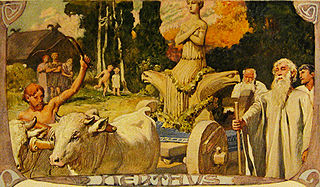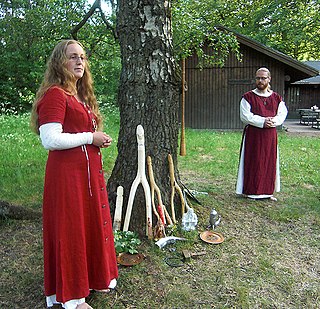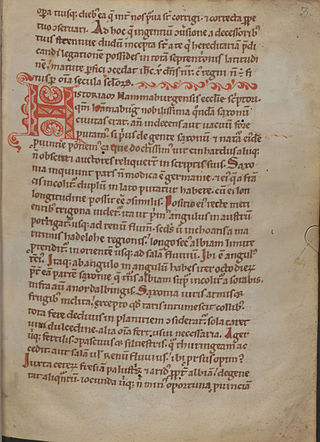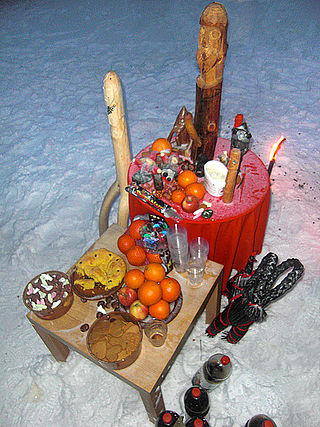Related Research Articles
"Edda" is an Old Norse term that has been applied by modern scholars to the collective of two Medieval Icelandic literary works: what is now known as the Prose Edda and an older collection of poems now known as the Poetic Edda. The term historically referred only to the Prose Edda, but this usage has fallen out of favour because of confusion with the other work. Both works were written down in Iceland during the 13th century in Icelandic, although they contain material from earlier traditional sources, reaching back into the Viking Age. The books provide the main sources for medieval skaldic tradition in Iceland and for Norse mythology.

Freyr, sometimes anglicized as Frey, is a widely attested god in Norse mythology, associated with kingship, fertility, peace, prosperity, fair weather, and good harvest. Freyr, sometimes referred to as Yngvi-Freyr, was especially associated with Sweden and seen as an ancestor of the Swedish royal house. According to Adam of Bremen, Freyr was associated with peace and pleasure, and was represented with a phallic statue in the Temple at Uppsala. According to Snorri Sturluson, Freyr was "the most renowned of the æsir", and was venerated for good harvest and peace.
Norse is a demonym for Norsemen, a Medieval North Germanic ethnolinguistic group ancestral to modern Scandinavians, defined as speakers of Old Norse from about the 9th to the 13th centuries.

Scandinavia is a subregion of Northern Europe, with strong historical, cultural, and linguistic ties between its constituent peoples. Scandinavia most commonly refers to Denmark, Norway, and Sweden. It can sometimes also refer more narrowly to the Scandinavian Peninsula. In English usage, Scandinavia is sometimes used as a synonym for Nordic countries. Iceland and the Faroe Islands are sometimes included in Scandinavia for their ethnolinguistic relations with Sweden, Norway and Denmark. While Finland differs from other Nordic countries in this respect, some authors call it Scandinavian due to its economic and cultural similarities.

Vikings is the modern name given to seafaring people originally from Scandinavia, who from the late 8th to the late 11th centuries raided, pirated, traded and settled throughout parts of Europe. They also voyaged as far as the Mediterranean, North Africa, the Middle East, Greenland, and Vinland. In their countries of origin, and some of the countries they raided and settled in, this period is popularly known as the Viking Age, and the term "Viking" also commonly includes the inhabitants of the Scandinavian homelands as a whole. The Vikings had a profound impact on the early medieval history of Scandinavia, the British Isles, France, Estonia, and Kievan Rus'.

Æsir or ēse are gods in Germanic paganism. In Old Nordic religion and mythology, the precise meaning of the term "Æsir" is debated, with it being able to refer to both the gods in general or specifically to one of the main families of gods, in contrast to the Vanir, with whom they waged war, ultimately leading to a joining of the families. The term can further be used to describe local gods that were believed to live in specific features in the landscape such as fells. In the Old English Wið færstice, the Ēse are referred to, along with elves, as harmful beings that could cause a stabbing pain, although exactly how they were conceived of by the author of the text is unclear.

The Norsemen were a North Germanic ethnolinguistic group of the Early Middle Ages, during which they spoke the Old Norse language. The language belongs to the North Germanic branch of the Indo-European languages and is the predecessor of the modern Germanic languages of Scandinavia. During the late eighth century, Scandinavians embarked on a large-scale expansion in all directions, giving rise to the Viking Age. In English-language scholarship since the 19th century, Norse seafaring traders, settlers and warriors have commonly been referred to as Vikings. Historians of Anglo-Saxon England distinguish between Norse Vikings (Norsemen) from Norway, who mainly invaded and occupied the islands north and north-west of Britain, as well as Ireland and western Britain, and Danish Vikings, who principally invaded and occupied eastern Britain.
Nordic folklore is the folklore of Denmark, Norway, Sweden, Iceland and the Faroe Islands. It has common roots with, and has been mutually influenced by, folklore in England, Germany, the Low Countries, the Baltic countries, Finland and Sápmi. Folklore is a concept encompassing expressive traditions of a particular culture or group. The peoples of Scandinavia are heterogenous, as are the oral genres and material culture that has been common in their lands. However, there are some commonalities across Scandinavian folkloric traditions, among them a common ground in elements from Norse mythology as well as Christian conceptions of the world.

Germanic mythology consists of the body of myths native to the Germanic peoples, including Norse mythology, Anglo-Saxon mythology, and Continental Germanic mythology. It was a key element of Germanic paganism.

Old Norse religion, also known as Norse paganism, is a branch of Germanic religion which developed during the Proto-Norse period, when the North Germanic peoples separated into a distinct branch of the Germanic peoples. It was replaced by Christianity and forgotten during the Christianisation of Scandinavia. Scholars reconstruct aspects of North Germanic Religion by historical linguistics, archaeology, toponymy, and records left by North Germanic peoples, such as runic inscriptions in the Younger Futhark, a distinctly North Germanic extension of the runic alphabet. Numerous Old Norse works dated to the 13th-century record Norse mythology, a component of North Germanic religion.

The Viking revival was a movement reflecting new interest in, and appreciation for Viking medieval history and culture. Interest was reawakened in the late 18th and 19th centuries, often with added heroic overtones typical of that Romantic era.
Forn Sed Norge, formerly Foreningen Forn Sed, is a Norwegian heathen religious organization.
Åsatrufellesskapet Bifrost is a Norse neopagan organisation in Norway. It was founded in 1996 and acts as an umbrella organisation for a number of local groups in Norway.

The Community of Forn Sed Sweden, formerly the Swedish Asatro Community is a heathen organization founded in 1994.

Gesta Hammaburgensis ecclesiae pontificum is a historical treatise written between 1073 and 1076 by Adam of Bremen, who made additions (scholia) to the text until his death . It is one of the most important sources of the medieval history of Northern Europe, and the oldest textual source reporting the discovery of coastal North America.

Modern paganism in Scandinavia is almost exclusively dominated by Germanic Heathenry, in forms and groups reviving Norse paganism. These are generally split into two streams characterised by a different approach to folk and folklore: Ásatrú, a movement that been associated with the most innovative and Edda-based approaches within Heathenry, and Forn Siðr, Forn Sed or Nordisk Sed, a movement marked by being generally more traditionalist, ethnic-focused and folklore-rooted, characterised by a worldview which its proponents call folketro. Forn Siðr may also be a term for Scandinavian Heathenry in general. Vanatrú defines the religion of those individuals or groups in which the worship of the Vanir dominates.

Norse, Nordic, or Scandinavian mythology is the body of myths belonging to the North Germanic peoples, stemming from Old Norse religion and continuing after the Christianization of Scandinavia, and into the Nordic folklore of the modern period. The northernmost extension of Germanic mythology and stemming from Proto-Germanic folklore, Norse mythology consists of tales of various deities, beings, and heroes derived from numerous sources from both before and after the pagan period, including medieval manuscripts, archaeological representations, and folk tradition. The source texts mention numerous gods such as the thunder-god Thor, the raven-flanked god Odin, the goddess Freyja, and numerous other deities.
Peter Godfrey Foote was a scholar of Old Norse literature and Scandinavian studies. He inaugurated the Department of Scandinavian Studies at University College London, and headed it for 20 years.

North Germanic peoples, commonly called Scandinavians, Nordic peoples and in a medieval context Norsemen, were a Germanic linguistic group originating from the Scandinavian Peninsula. They are identified by their cultural similarities, common ancestry and common use of the Proto-Norse language from around 200 AD, a language that around 800 AD became the Old Norse language, which in turn later became the North Germanic languages of today.

Trees hold a particular role in Germanic paganism and Germanic mythology, both as individuals and in groups. The central role of trees in Germanic religion is noted in the earliest written reports about the Germanic peoples, with the Roman historian Tacitus stating that Germanic cult practices took place exclusively in groves rather than temples. Scholars consider that reverence for and rites performed at individual trees are derived from the mythological role of the world tree, Yggdrasil; onomastic and some historical evidence also connects individual deities to both groves and individual trees. After Christianisation, trees continue to play a significant role in the folk beliefs of the Germanic peoples.
References
- 1 2 3 4 5 6 7 8 Evans, Clay Bonnyman (21 February 2023). "As all things Nordic become chic, scholar steps in". Colorado Arts and Sciences Magazine. University of Colorado Boulder . Retrieved 12 November 2023.
- 1 2 3 4 Amster, Matthew H. (2015). "It's Not Easy Being Apolitical: Reconstruction and Eclecticism in Danish Asatro". In Rountree, Kathryn (ed.). Contemporary Pagan and Native Faith Movements in Europe: Colonialist and Nationalist Impulses. New York and Oxford: Berghahn. pp. 53–58. ISBN 978-1-78238-646-9.
- 1 2 3 Abildlund, Andreas (13 June 2014). "Were the Vikings scared of volcanoes?". ScienceNordic. Translated by Gøtzsche Thiele, Iben. Retrieved 12 November 2023.
- ↑ Braithwaite-Westoby, Manu (2022). "Mathias Nordvig. Volcanoes in Old Norse Mythology: Myth and Environment in Early Iceland. Leeds, UK: ARC Humanities Press, 2021. Pp. 156" . Scandinavian Studies . 94 (2): 257–259. doi:10.5406/21638195.94.2.09. S2CID 248931558 – via Project MUSE.
- ↑ Hennig, Reinhard; Lethbridge, Emily; Schulte, Michael (2023). "Combining Ecocriticism and Old Norse Studies: Opportunities and Challenges". In Hennig, Reinhard; Lethbridge, Emily; Schulte, Michael (eds.). Ecocriticism and Old Norse Studies: Nature and the Environment in Old Norse Literature and Culture. The North Atlantic World: Land and Sea as Cultural Space, AD 400–1900. Vol. 7. Brepols Publishers. p. 24. doi: 10.1484/M.NAW-EB.5.134093 . ISBN 978-2-503-60485-5.
- ↑ Taggart, Declan (2018). How Thor Lost His Thunder: The Changing Faces of an Old Norse God. Abingdon and New York: Routledge. ISBN 978-1-315-16446-5.
- ↑ McDonald, Roderick (2018). "Old Norse Mythology: Comparative perspectives". Journal of the Australian Early Medieval Association . 14: 102 – via Google Books.
- ↑ Piet, Jules (2022). "Religious conversions in Adam of Bremen's Gesta Hammaburgensis Ecclesiae Pontificum and in Saxo Grammaticus' Gesta Danorum: A comparative approach". In Bartusik, Grzegorz; Biskup, Radosław; Morawiec, Jakub (eds.). Adam of Bremen's Gesta Hammaburgensis Ecclesiae Pontificum: Origins, Reception and Significance. Studies in Medieval History and Culture. Abingdon and New York: Routledge. pp. 136–137. doi:10.4324/9781003223030. ISBN 978-1-003-22303-0. S2CID 249588135 – via Google Books.
- ↑ Williamson, Jonathan (23 July 2023). "Top 11 podcasts navigating the Viking Age". The Viking Herald. Retrieved 24 November 2023.
- ↑ Williams, Howard M. R. (25 May 2023). "Archaeodeath and the Nordic Mythology Podcast". Archaeodeath. Retrieved 24 November 2023.